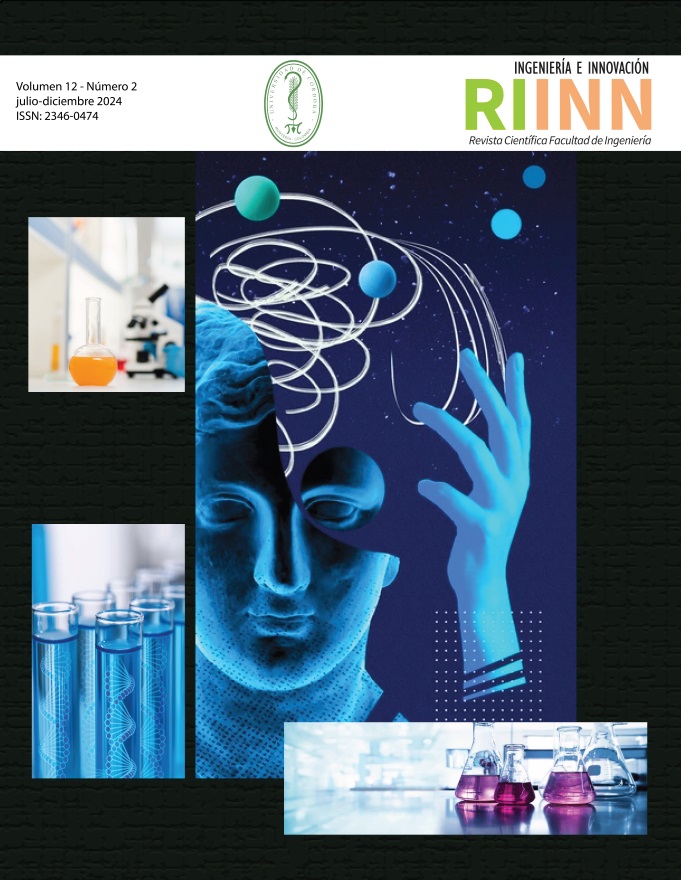Show authors biography
The objective of this article is to analyze the implementation of emerging
technologies in sports to improve the experience of athletes, coaches and
fans. The world of sports is in constant innovation, which requires efficient
management of specialized technological tools. These emerging technologies
focus on helping athletes perform better on the field, optimize training
regimens, and revolutionize decision-making processes. By using machine
learning algorithms, predictive analytics, and computer vision technologies,
effective strategies can be established. For this study, 40 articles were selected
from databases such as Scopus, ScienceDirect and IEEE. The main findings
indicate that technological tools not only improve competitiveness, but also
help prevent future injuries.
Article visits 9 | PDF visits
Downloads
- Adesida, Y., Papi, E., & McGregor, A. H. (2019). Exploring the role of wearable technology in sport kinematics and kinetics: A systematic review.
- In Sensors (Switzerland) (Vol. 19, Issue 7). MDPI AG. https://doi.org/10.3390/s19071597
- ALEXANDER, W. LINDSAY. (2019). ST. PAUL AT ATHENS (CLASSIC REPRINT). FORGOTTEN BOOKS. Apostolou, K., & Tjortjis, C. (2019, July 1). Sports
- Analytics algorithms for performance prediction. 10th International Conference on Information, Intelligence, Systems and Applications, IISA 2019.
- https://doi.org/10.1109/IISA.2019.8900754
- Araújo, D., Couceiro, M., Seifert, L., Sarmento, H., & Davids, K. (2021). Artificial intelligence in sport performance analysis. In Artificial Intelligence in Sport Performance Analysis. Taylor and Francis. https://doi.org/10.4324/9781003163589
- Biró, A., Cuesta-Vargas, A. I., & Szilágyi, L. (2024). AI-Assisted Fatigue and Stamina Control for Performance Sports on IMU-Generated Multivariate Times Series Datasets. Sensors, 24(1). https://doi.org/10.3390/s24010132
- Calderón, R. (n.d.). Universidad La Salle Bienes comunes digitales de la Universidad La Salle Piedras angulares de la investigación forense sobre delitos
- económicos Programa forense de delitos económicos !e Beneficios de la Inteligencia Arti&cial en Ciberseguridad.
- Chen, G., & Wu, H. (2024). Optimization simulation of sports stadium training based on Ant colony algorithm and sensor network. Measurement:
- Sensors, 33, 101100. https://doi.org/10.1016/j.measen.2024.101100
- Chen, Z., & Dai, X. (2024). Utilizing AI and IoT technologies for identifying risk factors in sports. Heliyon, 10(11). https://doi.org/10.1016/j.heliyon.2024.e32477
- Chidambaram, S., Maheswaran, Y., Patel, K., Sounderajah, V., Hashimoto, D. A., Seastedt, K. P., McGregor, A. H., Markar, S. R., & Darzi, A. (2022). Using
- Artificial Intelligence-Enhanced Sensing and Wearable Technology in Sports Medicine and Performance Optimisation. In Sensors (Vol. 22, Issue 18). MDPI. https://doi.org/10.3390/s22186920
- De Oliveira, M. S., Steffen, V., & Trojan, F. (2023). A systematic review of the literature on video assistant referees in soccer: Challenges and
- opportunities in sports analytics. Decisión Analytics Journal, 7. https://doi.org/10.1016/j.dajour.2023.100232
- Fuss, F. K. , S. A. , S. M. , & M. R. (2014). Routledge Handbook of Sports Technology and Engineering. Routledge.
- Goel, A. (2024). IS TECHNOLOGY A COMPLEMENT OR SUBSTITUTE TO REFEREEING IN SPORTS? A REVIEW (Review study). IJSTS International Journal of Sport Technology
- and Science International Journal of Sports Technology and Science, 2(1), 13–23. https://www.globsportsjournal.com/
- Gsangaya, M. R., Htwe, O., Selvi Naicker, A., Md Yusoff, B. A. H., Mohammad, N., Soh, E. Z. F., & Silvaraju M. (2023). Comparison between the effect
- of immersive virtual reality training versus conventional rehabilitation on limb loading and functional outcomes in patients after anterior
- cruciate ligament reconstruction: A prospective randomized controlled trial. Asia-Pacific Journal of Sports Medicine, Arthroscopy, Rehabilitation and
- Technology, 34, 28–37. https://doi.org/10.1016/j.asmart.2023.09.002
- Jager, E. W. H., Inganäs, O., & Lundström, I. (2000). Microrobots for micrometer-size objects in aqueous media: Potential tools for single-cell manipulation. Science, 288(5475), 2335–2338. https://doi.org/10.1126/science.288.5475.2335
- Jenkins, L., & Weerasekera, R. (2022). Sport-related back injury prevention with a wearable device. Biosensors and Bioelectronics: X, 11. https://doi.org/10.1016/j.biosx.2022.100202
- Khuyen, N. Q., Kiefer, R., Elhi, F., Anbarjafari, G., Martinez, J. G., & Tamm, T. (2020). A biomimetic approach to increasing soft actuator performance by friction reduction. Polymers, 12(5). https://doi.org/10.3390/POLYM12051120
- Kovoor, M., Durairaj, M., Karyakarte, M. S., Zair Hussain, M., Ashraf, M., & Maguluri, L. P. (2024). Sensorenhanced wearables and automated analytics
- for injury prevention in sports. Measurement: Sensors, 32, 101054. https://doi.org/10.1016/j. measen.2024.101054
- Li, Y., Kim, M., & Palkar, J. (2022). Using emerging technologies to promote creativity in education: A systematic review. International Journal
- of Educational Research Open, 3. https://doi.org/10.1016/j.ijedro.2022.100177
- Liu, Y., & Cao, S. (2024). The analysis of aerobics intelligent fitness system for neurorobotics based on big data and machine learning. Heliyon, 10(12). https://doi.org/10.1016/j.heliyon.2024.e33191
- Lopez‐barreiro, J., Alvarez‐sabucedo, L., Garcia‐soidan, J. L., & Santos‐gago, J. M. (2022). Use of Blockchain Technology in the Domain of Physical Exercise, Physical Activity, Sport, and Active Ageing: A Systematic Review. In International Journal of Environmental Research and Public Health (Vol.
- , Issue 13). MDPI. https://doi.org/10.3390/ijerph19138129
- Muniz-Pardos, B., Angeloudis, K., Guppy, F. M., Keramitsoglou, I., Sutehall, S., Bosch, A., Tanisawa, K., Hosokawa, Y., Ash, G. I., Schobersberger, W., Grundstein, A. J., Casa, D. J., Morrissey, M. C., Yamasawa, F., Zelenkova, I., Racinais, S., & Pitsiladis, Y. (2021). Wearable and telemedicine innovations for Olympic events and elite sport. In Journal of Sports Medicine and Physical Fitness (Vol. 61, Issue 8, pp. 1061–1072). Edizioni Minerva Medica. https://doi.org/10.23736/S0022-4707.21.12752-5
- Nguyen, H. S., & Voznak, M. (2024). A Bibliometric Analysis of Technology in Digital Health: Exploring Health Metaverse and Visualizing Emerging
- Healthcare Management Trends. IEEE Access, 12, 23887–23913. https://doi.org/10.1109/ACCESS.2024.3363165
- Petrović, L. T., Milovanović, D., & Desbordes, M. (2015). Emerging technologies and sports events: Innovative information and communication solutions.
- Sport, Business and Management: An International Journal, 5(2), 175–190. https://doi.org/10.1108/SBM-06-2012-0021
- Putranto, J. S., Heriyanto, J., Kenny, Achmad, S., & Kurniawan, A. (2022). Implementation of virtual reality technology for sports education and
- training: Systematic literature review. Procedia Computer Science, 216, 293–300. https://doi.org/10.1016/j.procs.2022.12.139
- Qie, X. (2023). Feedback delay of sports intelligent learning system based on model predictive control and artificial intelligence. Measurement: Sensors, 30. https://doi.org/10.1016/j.measen.2023.100922
- Qiu, Y., Liu, G., Muthu, B. A., & Sivaparthipan, C. B. (2022). Design of an energy- efficient IoT device with optimized data management in sports person
- health monitoring application. Transactions on Emerging Telecommunications Technologies, 33(10). https://doi.org/10.1002/ett.4258
- Ramirez-GarciaLuna, J. L., Bartlett, R., Arriaga-Caballero, J. E., Fraser, R. D. J., & Saiko, G. (2022). Infrared Thermography in Wound Care, Surgery, and Sports Medicine: A Review. In Frontiers in Physiology (Vol.13). Frontiers Media S.A. https://doi.org/10.3389/fphys.2022.838528
- Roggio, F., Bianco, A., Palma, A., Ravalli, S., Maugeri, G., Rosa, M. Di, & Musumeci, G. (2021). Technological advancements in the analysis of human motion and posture management through digital devices. World Journal of Orthopedics, 12(7), 467–484. https://doi.org/10.5312/wjo.v12.i7.467
- Seshadri, D. R., Magliato, S., Voos, J. E., & Drummond, C. (2019). Clinical translation of biomedical sensors for sports medicine. In Journal of Medical Engineering and Technology (Vol. 43, Issue 1, pp. 66–81). Taylor and Francis Ltd. https://doi.org/10.1080/03091902.2019.1612474
- Stevens, E., Espitia, F., Santo, U., Seccional, T., Julian, T., Triana, C., Universidad, Q., Tomas, S., & Tunja, S. (2023). Tecnología Vestible para Evaluar
- Capacidades Físicas de Fuerza y Velocidad de Ejecución en Deportistas: Revisión Narrativa.
- Tenforde, A. S., Iaccarino, M. A., Borgstrom, H., Hefner, J. E., Silver, J., Ahmed, M., Babu, A. N., Blauwet, C. A., Elson, L., Eng, C., Kotler, D., Homer, S., Makovitch, S., McInnis, K. C., Vora, A., & Borg- Stein, J. (2020). Telemedicine During COVID-19 for Outpatient Sports and Musculoskeletal Medicine
- Physicians. PM and R, 12(9), 926–932. https://doi.org/10.1002/pmrj.12422
- Van Biemen, T., Müller, D., & Mann, D. L. (2023). Virtual reality as a representative training environment for football referees. Human Movement Science,
- https://doi.org/10.1016/j.humov.2023.103091
- Wang, J. (2012). Research on application of virtual reality technology in competitive sports. Procedia Engineering, 29, 3659–3662. https://doi.org/10.1016/j.proeng.2012.01.548
- Wang, X., & Guo, Y. (2023). The intelligent football players’ motion recognition system based on convolutional neural network and big data. Heliyon, 9(11).
- https://doi.org/10.1016/j.heliyon.2023.e22316
- Wei, S., Huang, P., Li, R., Liu, Z., & Zou, Y. (2021). Exploring the Application of Artificial Intelligence in Sports Training: A Case Study Approach. Complexity, 2021. https://doi.org/10.1155/2021/4658937
- Yang, Y. (2024). Application of wearable devices based on artificial intelligence sensors in sports human health monitoring. Measurement: Sensors,
- , 101086. https://doi.org/10.1016/j.measen. 2024.101086
- Ye, S., Feng, S., Huang, L., & Bian, S. (2020). Recent Progress in Wearable Biosensors: From Healthcare Monitoring to Sports Analytics. In Biosensors (Vol.
- , Issue 12). MDPI. https://doi.org/10.3390/BIOS10120205
- Yu, S. (2021). Application of Blockchain-Based Sports Health Data Collection System in the Development of Sports Industry. Mobile Information Systems,
- https://doi.org/10.1155/2021/4663147
- Zhang, Y., Pi, Y., Wang, Q., Long, X., Wan, S., Liu, P., & Liu, Y. (2024). Application of video behavior fast detection based on wearable motion sensor devices in sports training. Measurement: Sensors, 33, 101096. https://doi.org/10.1016/j.measen.2024.101096
- Zhou, L. (2021). Molecularly Imprinted Sensor based on Ag-Au NPs/SPCE for Lactate Determination in Sweat for Healthcare and Sport Monitoring.
- International Journal of Electrochemical Science, 16, 1–13. https://doi.org/10.20964/2021.10.54




